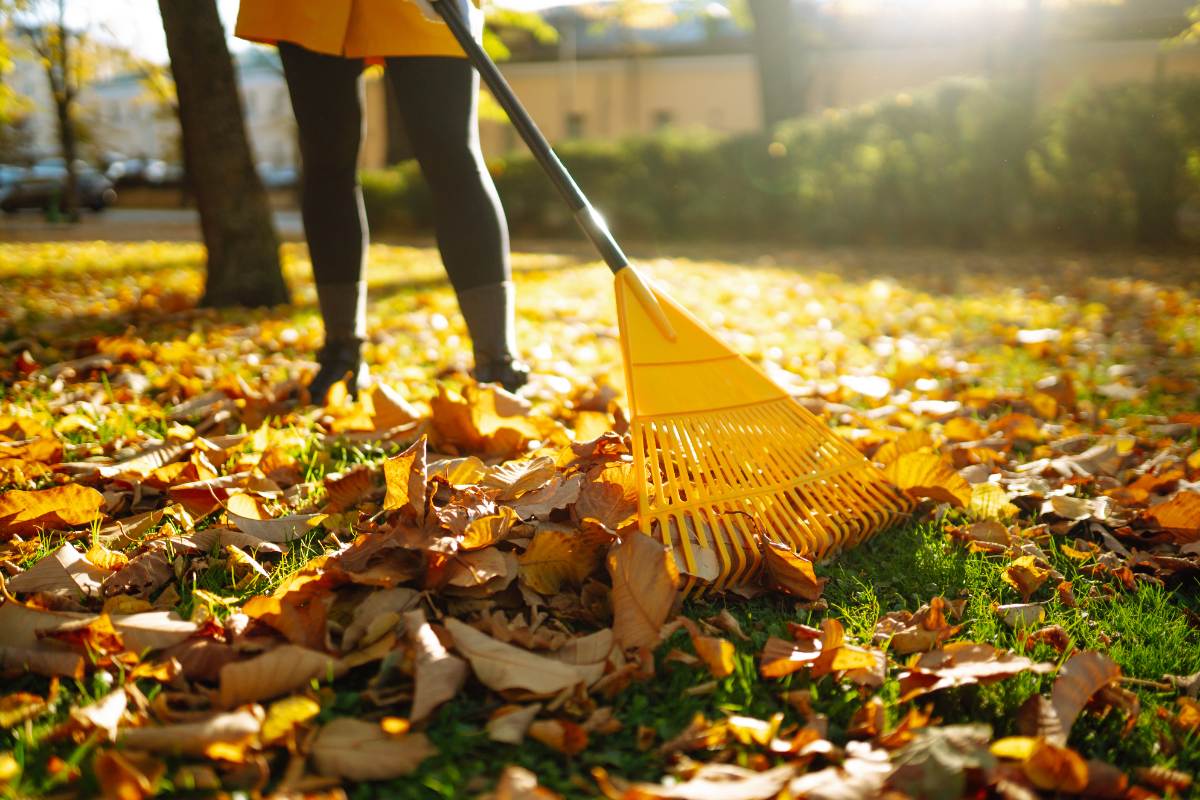
When leaves, seed pods, and acorns fall naturally from your neighbor’s tree onto your property, they’re legally yours to deal with — the tree owner has no obligation to remove them or compensate you for the cleanup.
But a neighbor intentionally blowing their fallen leaves into your yard? That’s different. You can ask them to stop, and a friendly discussion usually solves the problem. If talking doesn’t work, you can use several strategies to convince them.
We’ll show you how to handle the neighbor’s leaves in your yard and how to keep them from coming in with practical examples and expert advice.
Dealing with Falling Leaves vs. Blowing Leaves
According to common law, even if the tree belongs to your neighbor, the leaves that fall on your property are yours to deal with. The neighbor has no legal responsibility to remove them.
The same principle means that your neighbors should clean up what falls on their side and not blow their yard’s leaves onto your property.
Naturally Falling Leaves are Yours to Handle
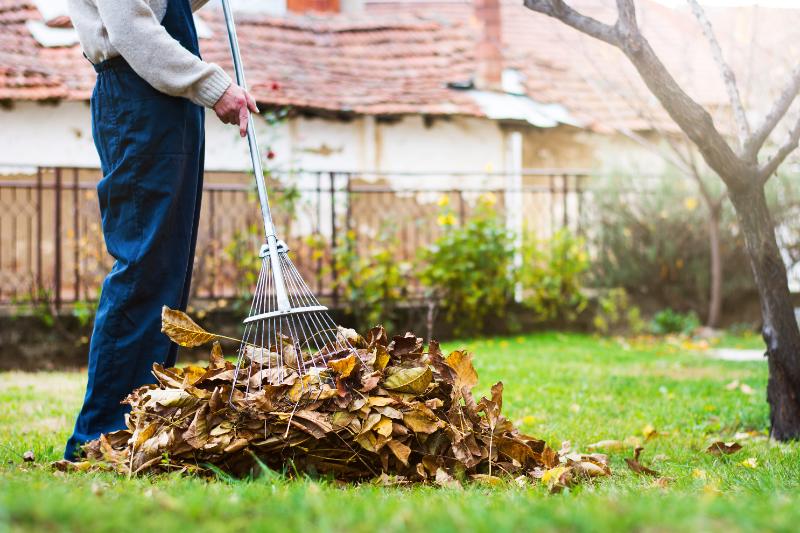
“That’s just how it works — wind blows, trees shed, and you deal with your yard,” says Reuben Wilt, a homeowner and the owner of Pool Screen Repair Tampa Bay.
Wilt doesn’t own any trees but still handles the fall cleanup yearly. ”I don’t even have leaf-bearing trees, but every season I’m still hauling 10+ bags that blew in. Do I like it? No. However, owning a house means you take care of it,” says Wilt.
For Wilt, the rule is simple: “You clean up the leaves that fall on your property. What’s on their (neighbor’s) side is their issue.”
What can you do with the leaves in your yard? You can rake the leaves for pick-up, or take advantage of nature’s gift and use the leaves to feed your garden and lawn:
- Shred the leaves and add to the compost.
- Chop them with a mulching mower and leave the pieces on the lawn as free fertilizer.
| Skip the raking. LawnStarter’s top-rated (4.3-star rating) leaf removal service averages just $158. Let us handle the mess while you relax. |
Pro Tip: If leaves falling from a neighbor’s tree land on your roof, do yourself a favor and install gutter guards. The guards catch fallen leaves and prevent your gutters from clogging.
Got a pool? Installing the protective tarp at season’s end should be standard practice, but hiring a pool pro is another option if the pool needs cleaning before you shut it down for winter.
Some homeowners install pool screens or cages for year-round protection. “A good pool screen keeps leaves out of the water, lessens skimming, and saves you cleaning time,” says Wilt, who has seen his fair share of leaf-covered pools.
See Related:
If Neighbors Blow Leaves into Your Yard, Try Talking

How to stop neighbors from blowing leaves in your yard? Start by talking with your neighbor. Assume it’s an honest mistake; it often is. Explain that you’re making an effort to keep your yard clean and that blowing leaves on your property causes more work for you. Most people will be open to correcting their behavior.
If repeated discussions lead nowhere, consider whether you want to stop there and simply clean up the neighbor’s leaves (if it’s not a major issue), or take other measures, such as:
- Contact the HOA or Code Enforcement (if local rules apply)
- Try mediation
- Send a formal demand letter
- Ultimately, you could sue your neighbor in small claims court.
Experts recommend documenting everything if you plan to go beyond friendly discussions. Keep a written log with dates and details, and take photos or videos.
Consider mediation before taking legal action, advises Robert Montanez, Esq., founding partner of Montanez Yu Personal Injury Lawyers. From his experience, “A neutral third party can often resolve leaf disputes without the expense or hostility of litigation.”
If mediation fails, Montanez recommends sending your neighbor a formal demand letter along with documentation, such as “photos, dates, and prior attempts to resolve the issue, which demonstrates good faith and strengthens the homeowner’s position if the matter later goes to court.”
According to Montanez, litigation is a last resort, when there’s “measurable financial or property damage, such as lawn care costs or damage to gutters.”
Rights and Legal Issues
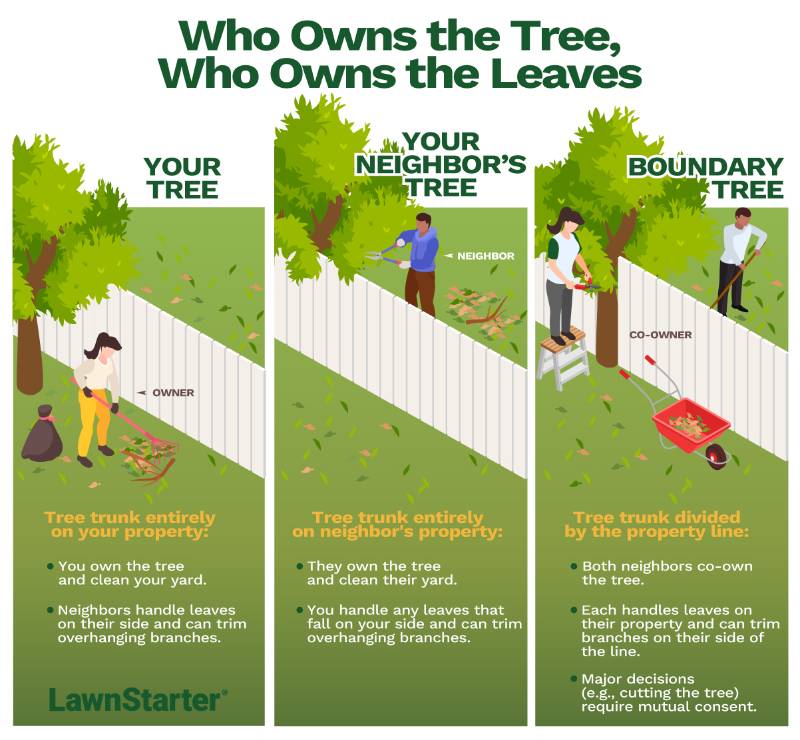
Who Owns the Tree, Who Owns the Leaves
Common law principles establish clear tree ownership rules:
- Tree trunk entirely on your property: You own the tree and clean your yard. Neighbors handle leaves on their side.
- Tree trunk entirely on neighbor’s property: They own the tree. You handle any leaves that fall on your side.
- Tree trunk divided by the property line: Both neighbors co-own the tree. Major decisions (e.g., cutting the tree) require mutual consent. Each handles leaves on their property.
See Related: Pricing Guide: How Much Does Tree Removal Cost?
Can You Trim Hanging Branches?
When asked about trimming a neighbor’s overhanging branches, Montanez advises proceeding carefully.
“Homeowners need to be careful when trimming branches that overhang onto their property. You have the right to cut back to your property line, but going further can create liability,” says Montanez.
Some smart precautions to take:
- Give your neighbors a heads up about trimming — they might even offer to handle it themselves.
- Consider hiring a tree care pro. Tree trimming costs $430 to $640 per tree on average, but that’s cheap compared to a potential lawsuit.
According to Montanez, a lawsuit for tree damage is a real risk. “Over-trimming that kills or disfigures the tree may expose you to lawsuits for property damage, aesthetic loss, or even the costs of tree replacement, which can often run into the thousands,” he says.
See Related:
- Trimming Trees on a Property Line: What Are Your Rights? Your Neighbor’s?
- 8 Common Tree Trimming Mistakes
Ways to Stop Leaves from Getting in Your Yard
Communicate with the Neighbor
Most neighbors want to get along and will respond positively when approached in a respectful manner. Here are a few tips on how to approach them:
- Be calm and positive
- Focus the talk on how the situation affects you, rather than their action
- Frame it as “our” challenge instead of “their” problem
- Suggest solutions, like planning a joint leaf cleaning day
Try something like:
“Hi, George! Your shrubs are looking great. Nice trimming! Listen, I wanted to discuss something minor with you. I’ve noticed that when you’re doing yard work, some leaves end up blowing over to my side. I’m sure it’s completely unintentional, but with my back problems, the extra cleanup is tough for me. Could we figure out a way to prevent this together?”
Install a Wooden or Vinyl Fence
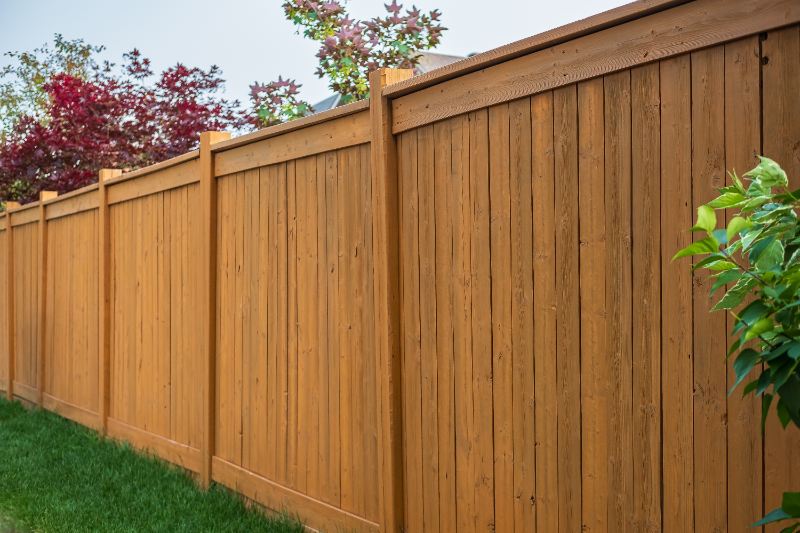
If wind brings tons of leaves from your neighbor’s yard, install a fence to stop them on the property line.
Fences create a vertical barrier that can stop leaves piling in your neighbor’s yard from drifting into yours. They won’t, however, stop the leaves that fall from above — from trees that are close to your property line or have overhanging branches.
You have several fence options to choose from:
- Solid fences made of wood or vinyl: Best options, but more expensive. They stop all leaf sizes, from large leaves to pine needles. Keep in mind that a wooden fence requires repainting or restaining every few years.
- Chain link fences or net fences: Cheaper and easier to install. Suitable for stopping large leaves.
How tall should a leaf barrier fence be? Even small 2-foot-tall fences will stop some leaves, as most of the time they drift close to the soil. But generally, the taller the fence, the better.
Strategic Landscaping
Well-planned landscaping can create natural barriers that catch your neighbor’s leaves before they reach your main yard areas. Consider these 2 simple solutions:
- Plant a privacy hedge along the property line. Some good shrubs to plant are privet, English laurel, and boxwood.
- Create a natural leaf barrier from tall ornamental grasses, such as pampas grass, feather reed grass, or blue oat grass.
Trim the Trees
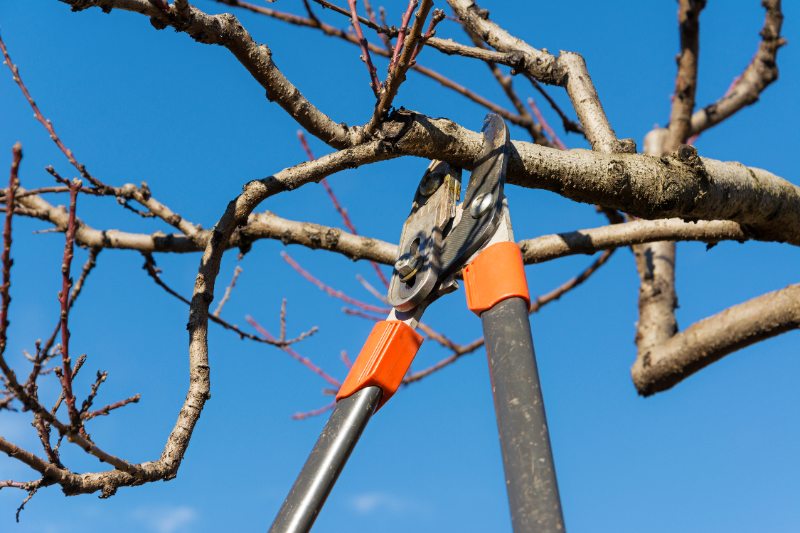
Trim the overhanging branches to reduce the amount of leaves your neighbor’s tree sheds in your yard. The best time to prune trees is late winter to early spring.
Can you throw the cut branches back into your neighbour’s yard? No. You’re responsible for disposing of the cut branches, unless your neighbour offers to take care of them.
FAQ
Your first option is to discuss the potential hazard posed by the tree with your neighbor. If there is pushback and you can’t get your neighbor to treat or cut the tree, you can contact Code Enforcement.
Yes. If you don’t remove fallen leaves, the heavy leaf coverage blocks sunlight and traps moisture, and can cause the grass to yellow, develop fungal diseases, and die.
Skip the Raking
Tired of cleaning up fallen leaves from your yard? Contact a LawnStarter leaf removal pro near you and forget about rakes, leaf blowers, and tarps. Relax and enjoy your crisp, green, leaf-free lawn.
Sources:
- “Pennsylvania Tree Laws: Property Rights and Legal Responsibilities.” Legal Clarity Pennsylvania.
- Reuben Wilt, owner of Pool Screen Repair Tampa Bay. Personal interview.
- Robert Montanez, founding partner, Montanez Yu Personal Injury Lawyers. Personal Interview.
- “Solving Disputes with Your Neighbors.” The People’s Law Library of Maryland.
- “Trees — A Unique Branch of Law.” By Kathleen K. Law, shareholder with Nyemaster Goode, P.C. in Des Moines, Iowa. Probate and Property, Vol. 31, No. 2.
Main Image: Person raking leaves in a yard. Image Credit: maxbelchenko / Adobe Stock